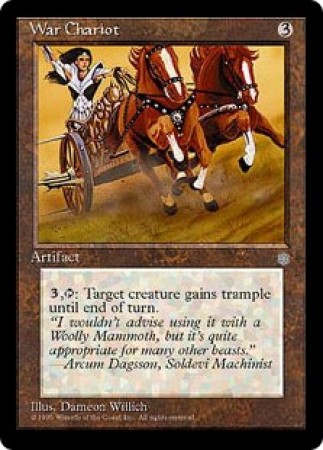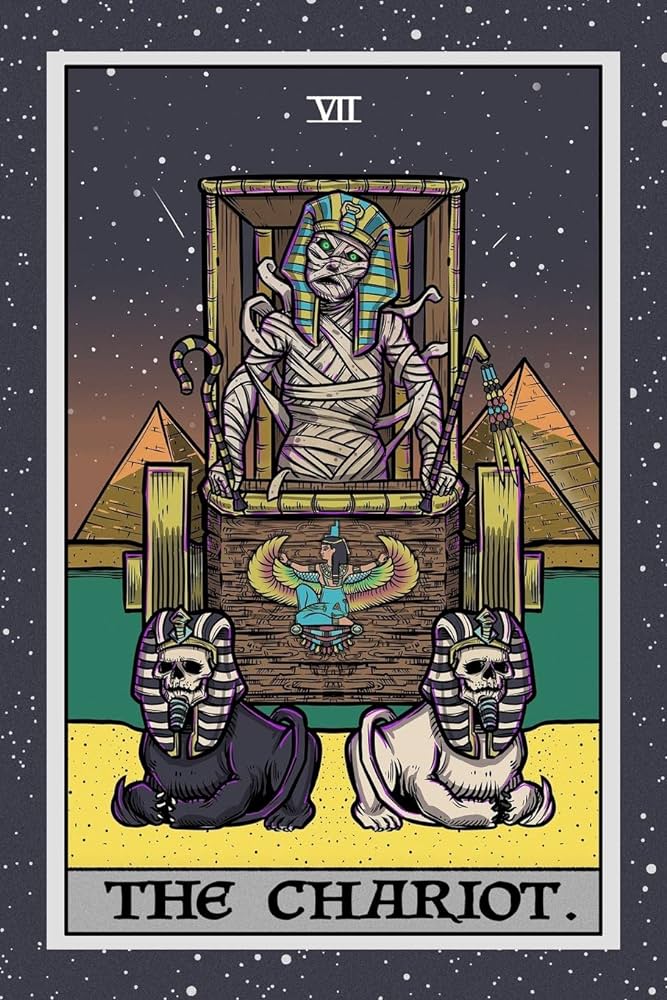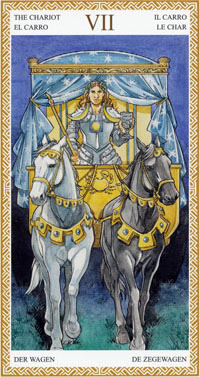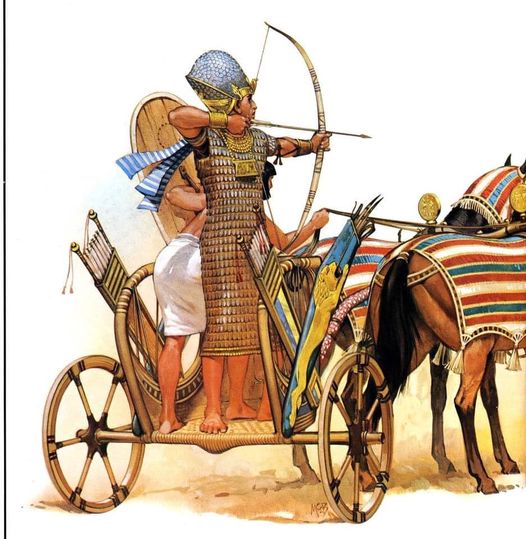| New Weapons | Equipment | - | Dragon #81 | Dragon magazine |
| A brief history | Chariots in the AD&D world | - | Construction and training | Weapons and warfare |
The development of chariots changed the
nature of combat during the early history of
mankind. The same thing will happen to an
AD&D campaign that incorporates
chariots.
Individual soldiers and warriors are
much more mobile, and more formidable,
when they sally forth into battle in a chariot
pulled by one or more powerful horses. But,
at the same time, charioteers can be vulnerable
to perils that footsoldiers don?t have to
worry about.
The Black Prince's
Chariot of Fear (Ral Partha)
A brief history
Archaeologists and historians have
uncovered evidence that chariots existed as
long ago as 2,000 years before the start of
the Iron Age. The wheeled vehicle was
probably invented in the Tigris-Euphrates
River area about 3500 B.C.; about 500
years later than that, two-wheeled vehicles
appeared in Mesopotamia. [Sumeria,
Babylon,
Assyria] Wheeled vehicles,
including the chariot, spread through
Asia and Europe and as far away as Sweden
and China during the next 17 centuries.
The Greeks were using chariots for
battles
and for racing before 800 B.C., most
notably in the Olympic games and at
Delphi. Greek racing chariots were light,
fragile constructions that were easily
smashed in collisions, often leaving the
drivers badly injured or killed. These chariots
were built light for speed, and to make
the inevitable crashes even more spectacular;
the races were a popular spectator sport
in those times. Celtic peoples introduced the
chariot to the British Isles in about 500
B.C., completing the spread of the chariot
throughout the civilized world.
The construction methods and materials
used in chariots varied greatly depending on
the use the vehicle was to be put to. Almost
all primitive chariots had wheels made of
two or three ?pie-slice? segments of wood
fastened together with transverse wooden
struts. The edges of these wheels were studded
with copper nails, or (especially after
2000 B.C.) fitted with bronze rims. The
wheels either turned independently on a
fixed axle or spun together on a rolling axle.
The domestication of the horse around
2000 B.C. had a profound effect on warfare;
now chariots could be pulled by animals
that had great mobility and maneuverability.
(Until that time, chariots had been
drawn by onagers, a breed of wild ass, or
some similar animal.) The invention of the
spoked wheel and the streamlined, semicircular
chassis, both of which probably
took place in India, further improved the
combat usefulness of chariots by making
them lighter (no more solid wheels) and
faster (less wind resistance).
At the same time, chariots became
heavier to better withstand the ravages of
battle. Earlier vehicles were so light as to be
flimsy, usually consisting of a floor of
wooden planks or woven leather strips
enclosed-by a wicker dashboard. As they
developed into military machines, chariots
began to carry bronze plaques on the front
and sides for protection from attackers. The
Celts carried heaviness to an extreme, using
metal (sometimes inlaid with enamel) for
the axle, the draft pole (the rod projecting
from the front of the chariot, to which the
horses were hitched), and the side boards,
and often also using metal in the construction
of the wheels.
The military chariot was generally used
only by officers and the wealthy, because of
the expense of construction and maintenance
of such sophisticated vehicles; this
was particularly true of chariots drawn by
more than one horse. The earliest battle
chariot carried a spearman and a driver,
and was seldom actually used for fighting.
It was primarily a method of rapid transit
to, from, and across battlefields. It was
easier for an armed warrior to mount and
dismount from a chariot than from a horse,
and the presence of a driver meant that the
warrior-passenger didn?t have to worry
about steering or stopping, and was free to
concentrate on the more urgent matter of
engaging and defeating the enemy.
The art of charioteering was refined more
and more as time went on. It didn?t take
too long to discover that a warrior could
impart greater velocity to hurled weapons
(primarily spears and lances) if they were
tossed in the same direction the chariot was
going. Men on foot, of course, could be
trampled by horses or run over by the
wheels of a chariot. (This tactic was best
employed against unarmed men, because a
victim with a weapon stood a good chance
of being able to disable a horse when the
chariot got close enough.) British war chariots
had sword blades extending from their
axles, to cut the legs out from under the
Roman foot soldiers they were used against.

For AD&D game purposes and for simplicity,
chariots are of the most advanced
sort, and come in 3 types: 1-horse,
2-horse, and 4-horse chariots. Building
a chariot requires the services of a carpenter,
an armorer, a wagon builder, and a
horse trainer. Depending on the campaign
milieu, the carpenter and wagon-builder
roles may be combined in a chariot-builder
specialist, but the costs and time associated
with construction would not significantly
change. Used chariots and trained horses
may or may not be easy to find, again
depending on the campaign.
One-horse and two-horse chariots are
usually drawn by heavy warhorses. Fourhorse
chariots are usually drawn by draft
horses harnessed abreast of each other,
because of the teamwork required to pull
the vehicle and the general superiority in
endurance of draft horses over the long
haul. Four-horse chariots are more often
used as cargo carriers ? actually, they
resemble nothing so much as an ordinary
cart or wagon ? than as battle vehicles,
since they are much less maneuverable than
one-horse and two-horse chariots.
Below are three tables that contain statistics
on chariots in the AD&D game. The
carrying weights assume movement no
faster than the given movement rate; movement
is reduced in an inverse proportion to
the extra weight carried, down to one-half
normal movement when carrying a load of
twice the given weight. Beyond that point,
horses will be so severely slowed by the
weight that they will be unable to draw the
chariot at all for any length of time. When
charging, the horse(s) drawing a chariot can
move at 150% of the rate given; thus, a
one-horse chariot drawn by a heavy
warhorse could move at 15" when charging.
A chariot starting from a stationary position
can ?walk? through a turn with a
radius only slightly greater than the distance
from the horse's nose to the axle. A chariot
already in motion can turn through a maximum
arc as described in the third table
below. The sharpness of the turn (the
expanse of the arc the chariot can turn
through in one round) depends on the chariot
type, the amount of weight being pulled
(which affects the movement rate), and the
speed of the vehicle at the time the turning
maneuver is started. For example, a non-encumbered
four-horse driven chariot drawn by
heavy warhorses moving at full speed (15")
can turn through an arc of 90 degrees in
1 round, which menas it could make a
circle of 60" circumference in 4 founds'
time. This circle has a radius of about 9 1/2"
-- not a very sharp turn, at the scale of
1" = 10 yards. The same chariot can make a
sharper turn in less time by sacrificing
speed; at one-quarter of its full movement
rate, the vehicle can make a 180-degree
turn in one round and can turn in a circle of
7½? circumference in two rounds. This
circle has a radius of about 1.2?, or 12
yards.
Chariot movement rates
| Type | LWH | MWH | HWH | DH |
| 1-horse | 16" | 12" | 10" | 8" |
| 2-horse | 20" | 15" | 12" | 10" |
| 4-horse | 24" | 18" | 15" | 12" |
| Type | LWH | MWH | HWH | DH |
| 1-horse | 500# | 650# | 700# | 800# |
| 2-horse | 1050# | 1400# | 1500# | 1650# |
| 4-horse | 1600# | 2050# | 2400# | 2600# |
| Type | Chg. | Full | 3/4 | 1/2 | 1/4 |
| 1-horse | 120 | 180 | 240 | 300 | 360 |
| 2-horse | 90 | 135 | 180 | 225 | 270 |
| 4-horse | 60 | 90 | 120 | 150 | 180 |

The ?weight carryable? table assumes
non-magic armor equivalent to plate mail
on the front, back, and sides of the chariot.
The ?weight carryable? figures are in addition
to the weight of the vehicle itself, so
that a one-horse chariot drawn by a light
warhorse is able to carry a pair of 200-
pound men (driver and warrior), plus their
armor and gear, with a few pounds? worth
of carrying capacity left over. A chariot
adorned with lighter armor, or no armor at
all, would be able to carry more weight ?
up to the limit of the structural strength of
the chariot, of course. The carrying capacity
of a leather-armored chariot would
increase by 2000 gp per horse (4000 gp for a
two-horse vehicle, 8000 gp for a four-horse
vehicle), while a non-armored chariot made
of a material like wicker would afford an
extra 2200 gp weight per horse while enabling
the chariot to retain the movement
rates given in the first table.
Normally, chariot building will take about
one month. The cost of constructing the
chariot alone is 250 gp for a one-horse
vehicle, 500 gp for a two-horse vehicle, and
750 gp for a four-horse chariot. These costs
do not include horses, harnesses, barding,
and other accoutrements.
The construction time can be reduced by
one day for each 10% addition to the original
construction cost; however, no more
than one week can be taken off the construction
time in this manner without a loss
of quality and/or stability in the finished
chariot. For each day less than three weeks
that it takes to finish a chariot, there is a
5% chance (cumulative) that the chariot
will have a serious breakdown whenever it
is driven over rough terrain or into battle.
(The chance is 10% for a construction time
of three weeks minus two days, 15% for
three weeks minus three days, etc.) This
breakdown may be relatively minor, such
as the loss of a piece of armor plating; more
probably, it will be something major, like a
broken axle or draft pole, or the loss of a
wheel. Any of these last 3 mishaps
would almost certainly cause a wreck and
injure the driver and any passengers.
A chariot-builder who is skilled and honest
may provide characters with some good
advice on what kind of vehicle is best suited
for the terrain over which it will be driven.
A 1-horse chariot can cross any terrain
that a heavy warhorse can cross while carrying
a rider and equipment, except for soft
ground (chariot wheels would get bogged
down) or narrow passages (such as a trail
through a swamp). A 2-horse chariot
is
similarly limited, and can move at only 1/2
normal rate in mountainous areas,
heavy forest, and similar tough terrain. A
4-horse chariot may only be driven over
hilly, plain, scrub, and hard-packed desert
terrain (wind-blown sand dunes would not
allow passage), or on a well-kept road or
track.
A chariot can be built with carrying
places within easy reach of the driver and
passenger for various weapons, and may
also have special minor modifications such
as scroll-case compartments, hooks and
niches for oil flasks, and the like. A friendly
chariot-builder will include ?options? like
these at little or no extra cost if they are
requested before construction has begun.
Other more lavish or more unusual modifications,
such as hidden compartments and
gaudy decorations, can be built in but will
add at least 20% to the construction cost
and at least an extra two days to the building
time.
A character who has bought a chariot or
paid to have one constructed must spend at
least one week ?per horse? learning how to
drive the vehicle with proficiency (i.e., four
weeks for a four-horse chariot). Many variables
can affect the cost and time of this
training, such as the level and skill of the
teacher, the level of the pupil, alignment
differences between the two, racial adjustments,
and so forth. A figure of 50 gp per
week would serve as a base training cost, to
be adjusted as the DM sees fit.
Weapons and warfare
The spear and javelin have historically
been a charioteer?s favorite weapons.
Hurled weapons gain exceptional striking
power when used from chariots, translated
as a +2 bonus to damage if cast forward (in
the direction the chariot is moving) at a
target while the chariot is at full speed or
charging. Note, however, that the weapon
does not gain a bonus ?to hit? when used in
this manner ? and the DM may even
assign a penalty ?to hit? for a character
who has not practiced hurling a weapon
from a moving chariot, or for someone who
is attempting it in battle for the first time.
Other weapons may be employed from a
chariot, but it may be difficult to use them
effectively. Missile weapons (which can be
used only if the weapon-wielder is not the
driver) have a -2 penalty ?to hit? when
fired from a chariot moving at half to full
speed, and a -4 penalty ?to hit? when fired
from a charging vehicle. One-handed striking
and thrusting weapons may be swung at
nearby opponents at the normal ?to hit?
chance ? unless the wielder is also the
driver, in which case he must take a -4
penalty ?to hit? because he must keep the
reins held in his other hand. Two-handed
weapons like pole arms, battle axes, and
huge swords can only be used by someone
other than the driver. If the driver decides
to drop the reins and use any weapon to
attack, he suffers a -2 penalty ?to hit? in
addition to any other penalties that apply,
because he is no longer able to control the
direction and speed of the chariot.
A charioteer using a thrusting weapon
such as a lance, a held spear, or certain pole
arms gains a +2 bonus ?to hit? against
opponents in range of the thrust, and the
weapon will do double normal damage if it
hits while the chariot is charging. Note,
however, that these rules only apply if the
thrusting weapon is used in a thrust, not if
it is swung at an opponent. Also, there are
special problems involved. If an attack of
this type scores a hit, the weapon must save
vs. normal blow, or the shaft will break and
the weapon will be useless thereafter. (Treat
the shaft as ?thick wood? on the saving
throw table, unless it is made of a different
material.) The character using the thrusting
weapon must roll his ?open doors? chance
to avoid being hurled from the chariot by
the shock of the impact ? assuming that he
is holding onto the chariot or is otherwise
anchored inside it in the first place. A freestanding
driver or warrior who scores a hit
in this manner will always be thrown from
the chariot, whatever his strength. The use
of a thrusting weapon in this manner will
always allow the wielder the first attack
against a target on foot, regardless of initiative
rolls.
If he desires, the chariot driver may use a
medium or small shield while holding the
reins with his other hand; no penalties will
apply to the driver in terms of his ability to
drive or his capability to defend himself in
this manner.
In addition to their actual, physical combat
usefulness, chariots can serve as a psychological
weapon against certain opponents.
Any creature of less than 1 hit die
or smaller than size M that also has at least
low intelligence must make a morale check
or flee toward a place of safety when
?greeted? by a charging chariot, losing any
attack it would have otherwise been allowed
in that round.
The horse(s) pulling a moving chariot can
? and usually will ? trample any lowlying
creatures in its path. This group
includes, but is not limited to, snakes, small
animals, and men or humanoids who are
prone. Against creatures and characters
who are essentially helpless to prevent the
trampling, the DM should allow one automatic
hit (by kicking) appropriate to the
type of horse involved, plus an additional
1-3 kicks (only 1-2 for a one-horse chariot)
that are rolled as normal attacks. In addition,
the chariot gets one run-over attack
(rolled as if the driver had attacked the
victim) which will do 3-12 points of damage
if it hits. Because of the many variables
involved, the DM must moderate the out-
come of trampling attempts against men,
humanoids, or other creatures who are not
prone and helpless; unless deafened,
blinded, or otherwise incapacitated, a target
will usually be able to sidestep the onrushing
horse(s) as long as the target is capable
of movement. A target that doesn?t sidestep
quite far enough may be hit by short blades
attached to the outside of the chariot?s wheel
hubs. Each blade does 2-5 points of damage
if it hits, again making the attack as if the
driver of the chariot was rolling to hit.

Opponents who use good tactics do have
a chance against a chariot. Monsters of
average intelligence or higher, especially
humanoids and other creatures who can use
missile weapons, will often attack a chariot?s
horse(s) in preference to the driver, in the
hope of upsetting the chariot. If any of the
horse(s) pulling a chariot sustains damage
equal to one-third or more of its original hit
points, the animal will panic, and other
horses, even if uninjured, may follow suit.
The driver has a 10% chance per level of
experience to be able to bring the horse(s)
back under his control, and if that doesn?t
happen, the chariot will crash. A chariot
crash will do 1-8 points of damage per 6? of
speed (round down) to the driver and any
passengers. If a horse is seriously wounded
(more than 50% hit-point loss) or killed and
the driver does manage to maintain control
of the vehicle, the best he will be able to do
is bring the chariot to a stop, and it cannot
be driven any further until a fresh horse is
hitched up.

The accompanying diagram shows topdown
views of what each type of chariot
might look like, with shaded areas indicating
the effective ranges of various attacks
that can be effected by the occupants and
the horses. As in all situations involving
rapid movement, the DM must keep careful
track of the locations of all characters, animals,
and vehicles involved in a confrontation
to determine if and when combatants
are within striking distance of one another.
<ADD DIAGRAM HERE>
